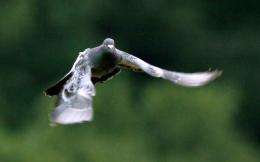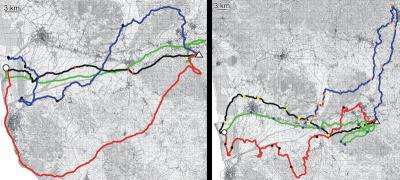Birds use right nostril to navigate

(PhysOrg.com) -- Pigeons rely mainly on their olfactory sense when they navigate. Young pigeons learn to recognize environmental odours carried by the winds into the loft and to use these odours to find their way home from unfamiliar territory. Scientists from the Max Planck Institute for Ornithology in Radolfzell, Anna Gagliardo from the University of Pisa, and their colleagues at the University of Trient recently demonstrated that pigeons navigate more poorly with their right nostril blocked.
This finding suggests that the left brain hemisphere, where olfactory information is processed, is of fundamental importance to the orientation and navigation of homing pigeons. (Journal of Experimental Biology, January 27, 2011)
The amazing ability of pigeons to find their way to their home loft has been known for centuries. According to scientists, these birds possess a distinctive olfactory sense as well as a capacity for recognizing odours, which helps them to develop a kind of “scent map” of their surroundings. However, it seems that pigeons cannot smell similarly with both nostrils. Like humans, they can detect odours better through their right nostril.
Martin Wikelski from the Max Planck Institute for Ornithology in Radolfzell and Anna Gagliardo from the University of Pisa recently completed a study of 31 pigeons to determine how the birds’ orientation would be affected if the they were unable to smell through their right nostril. The scientists inserted small, rubbery, removable plugs into the left nostril of some of the birds and into the right nostril of others. All the pigeons were hand-raised in the area around of Pisa. After fixing small GPS data loggers on the pigeons’ backs, the researchers released the pigeons near Cigoli, a Tuscan village 42 km away from the birds’ home.

Based on the GPS data they collected, the scientists found that the pigeons that could not breathe through their right nostril took a more tortuous route. They stopped more often, and spent more time exploring the surroundings of the stopover sites than those birds that could smell with their right nostril. “We suppose that these birds had to stop to gather additional information about their surroundings because they could not navigate by their olfactory sense,” says Anna Gagliardo. “This behaviour not only indicates that an asymmetry exists in the perception and processing of odours between the left and the right olfactory system; it also shows that the right nostril apparently plays an important role in processing olfactory information in the left hemisphere that is useful for navigation.” How the pigeons’ brains process these sensory perceptions, and why this processing is asymmetric, the researchers do not yet know.
More information: Anna Gagliardo, Caterina Filannino, Paolo Joalè, Tommaso Pecchia, Martin Wikelski, Giogio Vallortigara, Olfactory Lateralization in homing Pigeons: a GPs Study on Birds released with Unilateral Olfactory Inputs, Journal of Experimental Biology, January 27, 2011; 214:593-598. doi: 10.1242/jeb 049510
Provided by Max-Planck-Gesellschaft


















